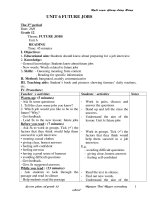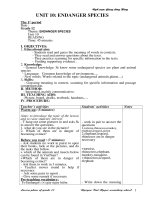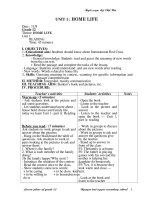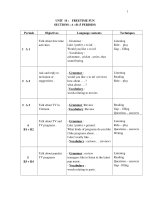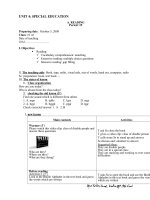Giáo án Solution (Intro+Unit 1+Unit 2)
Bạn đang xem bản rút gọn của tài liệu. Xem và tải ngay bản đầy đủ của tài liệu tại đây (469.78 KB, 96 trang )
Lesson plan Teacher: Võ Thụy Ngọc Dung
Solution Grade 6
INTRODUCTION
Part A: Everyday English
SAYING HELLO
I. OBJECTIVES:
After this lesson, students will be able to:
- introduce themselves
II. LANGUAGE CONTENT:
1. Functional English: introduce yourself
2. Listening: short dialogues
3. Vocabulary: letters and numbers
4. Speaking: introduce yourself
5. Topic: people
III. TECHNIQUES:
- Play role
IV. TEACHING AIDS:
- Textbooks, chalks, board
V. TIME: 90 minutes
VI. PROCEDURES:
Steps Teacher’s activities Students’ activities
Lead-in - Ask ss to work in groups and write down as
many English words as they can remember in
one minute
- Ask ss to read out a word from their list.
- Work in groups and write
down English words they
know
- Read out the word.
Exercise 1 - Draw ss’ attention to the photo on page 4
- Ask ss: “How old do you think the boy is?
How old is the girl?”
- Help ss with comprehension if necessary, by
saying for example: How old is he / she?
Fifteen, sixteen, seventeen or eighteen.
- T could write the numbers on the board when
speaking
- Look at the pictures on
page 4 and guess T’s
questions
- Answer the question
Exercise 2 - Ask ss read and listen to the dialogue
- Ask ss: “So, how old is Ben? How old is
Francesca?”
- Ask few ss: “How old are you?”
- Read and listen to the
dialogue
- Answer T’s questions
Exercise 3 - Play the alphabet for ss to listen to, then - Repeat chorally and
1
Lesson plan Teacher: Võ Thụy Ngọc Dung
Solution Grade 6
model it for them to repeat in group of 2 – 4
letters
- Point out the easily confused G and J
- Suggest some abbreviations which the ss
may know and which may be used as
mnemonics: for example DJ or GPS
individually
Exercise 4 - Ask ss work in groups of 4
- Play the tape twice, pause after each name
- Play the tape as many times as ss need
- Ask ss to show their worksheet on the board
- Ask ss to say each letter aloud
Transcript: Russell Crowe, Catherine Zeta
Jones, Whitney Houston, Roger Federer
- Work in groups
- Listen to the tape and
write the name of the
famous people
- Read aloud the letter
Exercise 5 - Ask ss to work in groups
- Ask ss to think the names of up to three
famous people
- Ask ss to read aloud the names
- If the other group can guess this name, they
will get one bonus.
- Work in groups
- Write about three famous
names and spell out before
the class
Exercise 6 - Play the tape for ss to listen to
- Model pronunciation for them to repeat in
group of 3 – 4
Transcript: 1 – 23, 30, 40, 50.
- Listen to the number
Exercise 7 - Ask some weaker ss to read aloud the
numbers from 1 to 20 and say them in reverse
- Ask anyone who makes a mistake has to pay
a forfeit, for example, say the name of an
English song, say the name of three countries
where English is spoken
- Say the numbers from 1
to 20
Exercise 8 - Ask ss to work in groups
- Play the tape twice
- Pause after every name has been spelled
- Ask ss to show their answer
Key:
1. Name: Siobhan Name: Dafydd
Age: 15 Age: 15
2. Name: Abdullah Name: Katharine
Age: 17 Age: 16
- Work in groups
- Listen to short dialogues
- Write the names and ages
- Show their answer to the
T
Exercise 9 - Ask ss to work individually
- Ask ss to compare their answers in pairs
- Work individually
- Check answer with their
2
Lesson plan Teacher: Võ Thụy Ngọc Dung
Solution Grade 6
- Check the answers before class
Key: 1b, 2d, 3a, 4c
friends
Exercise 10 - Ask ss to work on the pronunciation of the
questions
- Play each one several times and ask ss to
repeat and pay attention to the following
features: Each question is one tone unit, which
means it should be pronounced “like one word”
without stopping.
- In each question, there is a stressed word –
the one that carries the key meaning: What’s
your name? How old are you?
- Ask ss to practice the question intonation
- Practice speaking the
questions
- Repeat chorally and
individually
Exercise 11 - Ask ss to work in pairs and do the task 11 on
page 4
- Encourage ss to try without writing the
dialogues out in full
- Help ss practice the phrases, not insist if they
find it hard to do everything orally
- Work in pairs
- Practice speaking as
required
Exercise 12 - Ask some pairs to act out the dialogue
- Give feedback: praise good performance and
correct a few mistakes (especially concerning
pronunciation or the language from this lesson)
- Some ss act out the
dialogue in front of the class
- The others watch their
friends’ performance and
give some comments.
Further
practice
- Ask ss to say the alphabet around the class
backwards
- Whoever makes a mistake (gives the wrong
letter or pronounces it incorrectly) must pay a
forfeit. Here are some ideas for what ss to do for
forfeits:
1. Say three English names used by men /
women
2. Say the name of a country in English
- Do as T required
3
Lesson plan Teacher: Võ Thụy Ngọc Dung
Solution Grade 6
3. Say the names of two cities in Britain
4. Say two titles of songs in English
5. Say the title of a film in English
Consolidation - Ask ss: “What have we talked about today?
- Elicit introductions of saying hello or saying
how old you are.
- Ask ss to repeat the alphabet and count from
1 to 20.
- Draw ss’ attention to the lesson statement: “I
can introduce myself.”
- Answer T’s question
- Say the questions and the
answers
- Repeat the alphabet and
count from 1 to 20
Homework:
- Learn by heart new words, numbers from 1 to 20
- Study the structures.
- Do workbook on page 4
INTRODUCTION
Part B: Grammar
BE, POSSESSIVES AND PRONOUNS
I. OBJECTIVES:
After this lesson, students will be able to:
- say someone’s possessive
II. LANGUAGE CONTENT:
1. Grammar: be, possessives, pronouns
2. Reading: a short personal profile
3. Speaking: ask and answer about personal information
III. TECHNIQUES:
- Group works, pair work
IV. TEACHING AIDS:
- Textbooks, chalks, board
V. TIME: 90 minutes
VI. PROCEDURES:
Steps Teacher’s activities Students’ activities
Lead – in - Ask a few ss the question: “How old are
you?”
- Answer T’s question
4
Lesson plan Teacher: Võ Thụy Ngọc Dung
Solution Grade 6
- Introduce the lesson: the today’s lesson will
be on the conjugation of the verb to be
Exercise 1 - Draw ss’ attention to the photo. Say
something like: “See – this is Ben from lesson
A”
- Ask ss to read the text and answer the
questions
- Check answers with the whole class
Key: 1. T, 2. F, 3. F
- Look at the photo
- Read the text and do
exercise 1
Exercise 2 - Remind ss that be is the infinitive
- Ask them to so the tasks
- When checking, ask for equivalents of the
forms in the ss’ own language.
- Point out the short answers and emphasize
that they are used a lot.
- Contractions (short forms) of the verb to be
are presented here and used throughout the
book. Point out to ss that contractions are
almost always presented in fluent speech and
informal writing and that the use of the full
form sounds unnatural.
- Do the task 2
individually
- Check answers with their
partners
Exercise 3 - Ask ss to do the task individually
- Ask them to complete the sentences so that
they are true about them
- Help with any languages that needs
explaining
- Go over answers with the whole class, where
- Do task 3 individually
- Complete the sentences
- Encourage ss to ask T
when they don’t understand
the requirement
5
Lesson plan Teacher: Võ Thụy Ngọc Dung
Solution Grade 6
two different answers are possible
Key:
1. am / am not
2. are / aren’t
3. are
4. is / isn’t
5. aren’t
6. is / isn’t
7. am / am not
8. is / isn’t
Exercise 4 - Ask ss to look at how questions are formed
- Ask ss to work in groups and do the task
- Model the first question for class
- Check answers with the whole class
Key:
1. Are you 15 years old?
2. Is Ronaldinho your favorite footballer?
3. Is our teacher in the classroom?
4. Are we from Hungary?
5. Is Julia Roberts your favorite actress?
6. Are you thirsty?
7. Are your friends at home?
- Do task 4 in groups
- Check answers
Exercise 5 - Do the first two or three questions in open
pairs (two ss ask and answer and the rest of the
group listens)
- Insist on answer in the form Yes, I am / No,
I’m not + the correct information as opposed to
- Watch T do the model
- Work in pairs and
practice
6
Lesson plan Teacher: Võ Thụy Ngọc Dung
Solution Grade 6
just yes and no
- Ask ss to do in pairs
- Ask some ss circulate and monitor
Exercise 6 - Explain what possessive adjectives are
- Ask a few ss questions like, “Is this your
pen? No, it isn’t. Oh, is it his?” with gestures to
indicate your meaning
- Work individually
- Complete the table
- Check answers with their
partners
Exercise 7 - Demonstrate the meaning of demonstrative
pronouns using objects in the classroom, for
example: This is my bad. These are chalks.
- Check understanding by eliciting some
examples from the class
- Ask ss why they have used this, that, these,
those
- Pronunciation /ᵭ/ can be produced by putting
the tip of the tongue against or even between the
teeth.
Key:
1. Are those your books?
2. Are these your trainers?
3. Is that your bike?
4. Is this your CD?
5. Are these your pencils?
- Read the Learn this! Box
- Look at the pictures and
write questions
- Check with the whole
class
- Practice the
pronunciation of /ᵭ/
Consolidation - Ask ss: “What have we talked about today?”
- Briefly revise the conjugation of to be
- Draw ss’ attention to the lesson statement: “I
can ask and answer questions.
- Answer T’s question
- Review the lesson
7
Lesson plan Teacher: Võ Thụy Ngọc Dung
Solution Grade 6
Homework:
- Learn new structures
- Do workbook on page 5
8
Lesson plan Teacher: Võ Thụy Ngọc Dung
Solution Grade 6
INTRODUCTION
Part C: Grammar and Vocabulary
HAVE GOT
I. OBJECTIVES:
After this lesson, students will be able to:
- talk about possession
- describe people
- write a short description
II. LANGUAGE CONTENT:
1. Grammar: have got
2. Vocabulary: personal appearance
3. Listening: short dialogue
4. Speaking: talk about what people have got and what people look like
5. Writing: a short description of a family member
6. Topic: people:
III. TECHNIQUES:
- Play role
- Question - answer
IV. TEACHING AIDS:
- Textbook, chalks, board, pictures
V. TIME: 90 minutes
VI. PROCEDURES:
Steps Teacher’s activities Students’ activities
Lead – in - Show T’s own picture and say: “This is my
sister.
- Ask ss: “Have you got sisters or brothers?”
- Answer T’s question:
“Yes / No”
9
Lesson plan Teacher: Võ Thụy Ngọc Dung
Solution Grade 6
- Write on the board have got and say this is
the topic of the lesson
Exercise 1 - Tell ss they are going to hear a conversation
between Ben and Francesca
- Focus ss’ attention on the picture and ask
them to read the task
- Play the recording once
- Allow a moment for everyone to finish
answering
- Check answers with the whole class
Key: 1. hasn’t 2. has 3. haven’t
- Listen to the recording a
conversation between Ben
and Francesca.
- Read the task silently
- Choose the correct
answers of task 1
Exercise 2 - Ask ss to complete task 2 individually
- Ask ss write their answers on the board
- Explain that ‘ve and ‘s are short forms of
have and has
- Point out that nearly all forms are the same,
just one different. Which one?
Key: 1. has 2. have 3. Have
4. hasn’t 5. haven’t
- Complete task 2
- Write answers on the
board
- Answer (he / she / it has)
Exercise 3 - Ask ss to read the example
- Do the first two sentences with the whole
class as a model
- Check any unknown vocabulary first and do
a few exam together
Key:
1. He’s got a bike.
2. He hasn’t got a computer.
- Do task 3 on page 6
- Watch T’s models
- Write sentences on their
exercise notebooks.
- Check answers with the
whole class
10
Lesson plan Teacher: Võ Thụy Ngọc Dung
Solution Grade 6
3. He has got a pet.
4. He hasn’t got an MP3 player
5. He’s got a skateboard.
6. He’s got a watch
7. He’s got a mobile phone
8. He hasn’t got a DVD player.
Exercise 4 - Ask ss to work in pairs
- Ask ss to use the things in exercise 3 to ask
and answer
- Call some pairs to perform in front of the
class
- Correct their pronunciation
- Work in pairs
- Ask and answer with
partners
- Some pairs perform in
front of the class
Exercise 5 - Ask ss the meaning of the adjectives in the
table
- Point out the order of adjectives
- Write these examples on the board: He’s got
long black hair; She’s got short curly hair. He’s
got straight, fair hair.
- Ask ss to put these three adjectives in the
right order before the word hair: She’s got wavy
/ dark / long hair. Answer: She’s got long,
wavy, dark hair.
- Ask ss to describe the first photo
- Ask ss to talk about the remaining ones in
pairs.
- Circulate and monitor, help with sentence
building and pronunciation.
- Give the meaning of the
adjectives
- Put the adjectives in the
right order
- Talk about the first photo
- Talk about the rest
11
Lesson plan Teacher: Võ Thụy Ngọc Dung
Solution Grade 6
- Ask few ss to describe the photos to the
whole class
- Give feedback: praise good sentences,
correct in target language (has got and the
appearance words)
Exercise 6 - Ask ss to practice speaking with their
partners
- Encourage them to use the words on the
table on exercise 5
- Act out in front of the class
- Correct their mistakes if necessary
- Practice speaking with
their partners
- Act out in front of the
class
Exercise 7 - Remind ss of the language they can use in
writing the description
- Tell ss it is also possible to say; “Her eyes
are black. His hair is long and dark.”
- Ask ss to write a description at home.
- Encourage ss to include a photo with the
description
- Tell the language is used
in writing the description
- Write a description at
home
Consolidation - Ask ss: “What have we talked about today?
- Elicit have got and appearance
- Ask everyone to say one word they learned
from the lesson
- Draw ss’ attention to the lesson statement: “I
can describe people.”
-
Homework:
- Write a description at home.
- Learn new words.
12
Lesson plan Teacher: Võ Thụy Ngọc Dung
Solution Grade 6
- Do workbook on page 6
13
Lesson plan Teacher: Võ Thụy Ngọc Dung
Solution Grade 6
INTRODUCTION
Part D: VOCABULARY
TIME, DAYS MONTHS AND SEASONS
I. OBJECTIVES:
After this lesson, students will be able to:
- ask for and tell the time
II. LANGUAGE CONTENT:
1. Vocabulary: time, days, months, seasons
2. Speaking: talk about time, days, months, seasons
3. Functional English: ask for and tell the time
III. TECHNIQUES:
- Group work, pair work
- Game
IV. TEACHING AIDS:
- Textbook, chalks, board, pictures
V. TIME: 90 minutes
VI. PROCEDURES:
Steps Teacher’s activities Students’ activities
Lead – in - Write the date on the board, first as numbers
then as words, e.g., 15/09/2010 (Wed) – Today
is Wednesday, the fifteenth of September two
thousand and ten.
- Read aloud what you have written
- Write the time, first as numbers, then as
words, e.g.; 8.30 – It is half past eight.
- Inform the class of the lesson topic: It would
- Listen to T
14
Lesson plan Teacher: Võ Thụy Ngọc Dung
Solution Grade 6
be good to have a calendar with the names of
the days and months in English on the wall in
your classroom
Exercise 1 - Ask ss to open their books and look at the
clocks
- Play the recording once for ss to listen and
then again, pause after each time for them to
repeat
- Open their books
- Listen to the recording
- Repeat
Exercise 2 - Ask ss work in pairs to do task 2
- Explain the requirements
- Play the recording once, then again, pause
after each time
- Ask ss to write each time on the board in
numbers
Key: 1/ 4.00 2/ 7.40 3/ 10.05
4/ 6.30 4/ 10.40 6/ 3.15
- Do task 2 in pairs
- Listen to the recording
- Write the time
Exercise 3 - Allow a moment for ss to read the
instructions, the dialogue and the words in the
box
- Explain the requirements if necessary
- Play the recording once
- Check the answer by getting a pair of
confident ss to read out the dialogues.
Key: 1. Excuse 2. time 3. to
4. very 5. Welcome
- Language note – Saying the time: To say a
time when the minutes are not multiple of five,
- Read the instruction
- Listen and complete the
dialogue
- Check answers with the
whole class
15
Lesson plan Teacher: Võ Thụy Ngọc Dung
Solution Grade 6
the word minutes must be added. E.g.: It’s two
minutes past ten.
Exercise 4 - Ask ss to practice the dialogue from exercise
3 in open pairs several times
- Ask them to work on intonation
- Ask them to talk about the times in this
exercise
- Circulate and monitor
- Work in pairs
- Practice speaking
dialogue form exercise 3
Exercise 5 - Ask ss to look at the task and read the
instructions
- Ask them to pick out a few words which are
days of the week and a few which are months
- Work on the exercise in
pairs
Exercise 6 - Play the part of the recording with the days
of the week
- Play it through for ss to check their answer,
pause after item for ss to repeat
- Point out the silent letters in Wednesday
- Listen to the recording
- Check answers
- Repeat the items
- Practice pronunciation
Exercise 7 - Give ss a minute or two to look at the
pictures
- Ask them to match the pictures with the
seasons
- Work individually
- Match the pictures and
the seasons
Exercise 8 - Play the recording and check ss’ answers to
exercise 7
- Ask ss to repeat the seasons chorally and
individually
Optional activity:
- Bring four big photos showing the four
seasons (cut out of calendars) and attach them
- Repeat the seasons
chorally and individually
- Pay special attention to
the pronunciation of the Au
in autumn
- Play game
16
Lesson plan Teacher: Võ Thụy Ngọc Dung
Solution Grade 6
to the board with magnets
- Ask four ss to come and write the names of
the seasons on the board under the photos
Exercise 9 - Ask ss to work in pairs
- Ask them to discuss the months and seasons
- Check with the whole class
Optional activity:
- Ask twelve ss to come to the board and
write the names of the months under the names
of the seasons
- Work in pairs
- Discuss in months
- Check with the whole
class
- Play game
Exercise 10 - Ask ss to work in pairs
- Practice speaking by asking and answering
the questions of task 10
- Check some pairs
- Call some pairs to act out in front of the
class
- Work in pairs
- Practice speaking
Consolidation - Ask ss: “What have we talked about today?”
- Elicit time or days of the week, months and
seasons
- Ask seven ss to say the days of the week in
order, then twelve to say the months in order
- Draw ss’ attention to the lesson statement: “I
can ask the time and talk about the month of the
year.”
- Answer T’s question
- Talk about time, days,
months and seasons
Homework:
- Learn days, months.
- Do workbook
17
Lesson plan Teacher: Võ Thụy Ngọc Dung
Solution Grade 6
18
Lesson plan Teacher: Võ Thụy Ngọc Dung
Solution Grade 6
Unit 1: MY NETWORK
Part A: Vocabulary and listening
FAMILY and FRIENDS
I. OBJECTIVES:
After this lesson, students will be able to:
- talk about family and friends
- describe a social network
II. LANGUAGE CONTENT:
1. Vocabulary: family members
2. Listening: description of a social network
3. Grammar: possessive ‘s singular and plural
4. Speaking: talk about family and friends
5. Topic: family life and relationships
III. TECHNIQUES:
- Group work, pair work
IV. TEACHING AIDS:
- Textbook, chalks, board, pictures
V. TIME: 90 minutes
VI. PROCEDURES:
Steps Teacher’s activities Students’ activities
Lead – in - Ask ss to close their books
- Inform the class of the lesson objectives by
saying: “Today’s topic is family.”
- Write family on the board
- Ask: “Do you know any words for members
of the family / people in the family?”
- Close books
- Find as many words
related to family as possible
- Say word aloud
19
Lesson plan Teacher: Võ Thụy Ngọc Dung
Solution Grade 6
- Give some prompt: “For example, ‘mother’
or…”
- Write words ss say on the board around the
word family
Exercise 1 - Ask ss to fill in the chart individually or in
pairs
- Elicit the fact that the word cousin is the
same for boys and girls
Key:
A: aunt, daughter, granddaughter, grandmother,
mother, niece, sister, wife
B: brother, father, grandfather, grandson,
husband, nephew, son, uncle
cousin is in both groups
- Fill in the chart
- Be able to use dictionary
Exercise 2 - Play the recording once
- Pause after each item for ss to repeat
chorally and individually
- Point out the final –r in mother, father,
sister, etc. is completely silent
- Listen to the recording
- Repeat chorally and
individually
Exercise 3 - Play the words for ss to hear
- Model the pronunciation yourself
- Ask a few ss to repeat
Key: mother, husband, son, uncle, brother,
grandson
- Listen to the words
- Observe T’s model
- Repeat
Exercise 4 - Play the recording once for ss to check their
answers
- Play it again and have ss repeat the words
individually
- Listen and check
answers
- Repeat the words
20
Lesson plan Teacher: Võ Thụy Ngọc Dung
Solution Grade 6
- Ask ss to pay attention to the pronunciation
of /ᴧ/
individually
Exercise 5 - Write on the board: “my uncle’s wife”
- Ask: “Who’s my uncle’s wife?”
- Allow a minute for ss to study the Learn
this! box.
- Write on the boars: “my dad’s car” and “my
parents’ car”
- Point to the apostrophe in the different
positions, and say: singular – plural
- Ask ss to complete the puzzles
- Check with the whole class
Key: 1. uncle 2. uncle 3. cousin
4. mother (or aunt) 5. niece 6. brother
- Answer: Aunt or Your
aunt
- Study Learn this! box
- Complete the puzzles
- Check with their partners
Exercise 6 - With a weaker class, specify: “Write 2 or 3
questions.”
- With a stronger class, provide a model like
this: “Who is my father’s granddaughter’s
mother?” Start with the whole class – two or
three ss ask a question each, the whole class
answer
- After that, ask ss to ask and answer in pairs
- Ask ss to go to Vocabulary Builder (part
1): Student’s book page 128
Key:
1. 1. brother 2. grandmother3. niece
4. husband 5. aunt 6. grandson
- Answer T’s question
- Answer: you – for a girl;
or your wife – for a boy; or
your sister, or your brother’s
wife
- Work in pairs
- Do exercise in
Vocabulary Builder (part
1): Student’s book page
128
21
Lesson plan Teacher: Võ Thụy Ngọc Dung
Solution Grade 6
7. nephew 8. Cousins
4. 3. That’s Jane’s skateboard.
4. John is at his cousins’ house.
5. Have you got Mark’s MP3 player?
6. The dog’s ball is under the tree.
7. What’s Maria’s phone number?
8. Where are the students’ books?
9. There are Peter’s pens.
10. That’s my grandparents’ house.
- Check answers with the
whole class
Exercise 7 - Draw ss’ attention to Laura’s network. The
“ME” in the middle is Laura; she has classified
the people in her life into three different
categories: school, family, free time
- Ask ss: "Would your categories be the same
or different?”
- Help ss to put their ideas into words
- Play the recording
Key:
Volleyball team: Hannah
Music group: Molly
Favorite teachers: Mr. Baker
Friends: Pete; Amy’s cousin, Jake
Family: Mark and Lucy, Sam
- Look at the picture on
page 8
- Answer T’s question
- Listen to the recording
Exercise 8 - Ask ss to draw a network of the people they
meet regularly
- Allow more time and possibly display the
results on the walls
- Draw a network at home
22
Lesson plan Teacher: Võ Thụy Ngọc Dung
Solution Grade 6
- Ask ss to do it at home
Exercise 9 - Provide a model first
- Put 3 – 4 names of real people from real
network on the board and encourage ss to ask:
“Who’s…?”
- Write the names your family and friends use
normally
- After speaking, ask ss to go to Vocabulary
Builder (Part 2): Student’s Book page 128
Key:
5.1. noses 2. watches 3. boxes 4.
videos
5. tomatoes 6. stories 7. Leaves
6. foot – feet; tooth – teeth; child – children
person – people; man – men; woman – women
7.2. These potatoes and tomatoes are delicious.
potato, tomato
3. Where are those men and women from?
man, woman
4. She’s got big eyes, and beautiful, white
teeth. eye, tooth
5. The children’s dictionaries are in the
classroom. child, dictionary
6. Have you got nephews and nieces? nephew,
niece
7. The glasses are on the shelves in the kitchen.
glass, shelf
- Observe T’s model
- Look at T’s network
- Ask about T’s network
- Practice speaking
- Do exercise on
Vocabulary Builder (Part
2): Student’s Book page
128
23
Lesson plan Teacher: Võ Thụy Ngọc Dung
Solution Grade 6
8.1. babies 2. feet 3. Watches
4. keys 5. sandwiches 6. Knives
7. children
Consolidation - Ask ss: “What have we talked about today?”
- Elicit: family.
- Ask: “Can you give me some words for
family members?”
- Praise ss who come up with the more
sophisticated ones, such as cousin, niece,
grandfather, etc.
- Draw attention to the lesson statement: “I
can talk about people I meet regularly.
- Talk about today’s
lesson
- Say some words for
family members.
Homework:
- Learn new words
- Do workbook on page 8
Unit 1: MY NETWORK
Part B: Grammar
PRESENT SIMPLE: Affirmative
I. OBJECTIVES:
After this lesson, students will be able to:
- use present simple tense: affirmative
- make statements about themselves and their families
II. LANGUAGE CONTENT:
1. Grammar: present simple tense: affirmative
24
Lesson plan Teacher: Võ Thụy Ngọc Dung
Solution Grade 6
2. Speaking: make statements about themselves and their families
III. TECHNIQUES:
- Group work, pair work
IV. TEACHING AIDS:
- Textbook, chalks, board, pictures
V. TIME: 90 minutes
VI. PROCEDURES:
Steps Teacher’s activities Students’ activities
Lead – in - Write on the board: present, past, future. Ask
ss what these words mean.
- Write the sentence I live in Ho Chi Minh
City. Ask: “Is this present, past or future?”
- Say: “Today, we are going to learn a tense
called the present simple.
- Look at the board
- Answer, use Vietnamese
to say the meaning
- Answer: It’s present
Exercise 1 - Draw ss’ attention to the picture of the
Simpson
- Elicit some names of his family members
Key: His dad’s name is Homer. His mum’s
name is Marge. He’s got two sister called Lisa
and Maggie.
- Look at the picture
- Try to say the name of
each member of the
Simpson.
Exercise 2 - Ask ss to read the text
- Check ss’ comprehension
- Teach new vocabulary
Vocabulary:
- popular (a) - study hard (v)
- programme (n) - power station
(n)
- Read the text
- Ask T new words that
they don’t know the
meaning
- Write new words on
their notebooks
25


